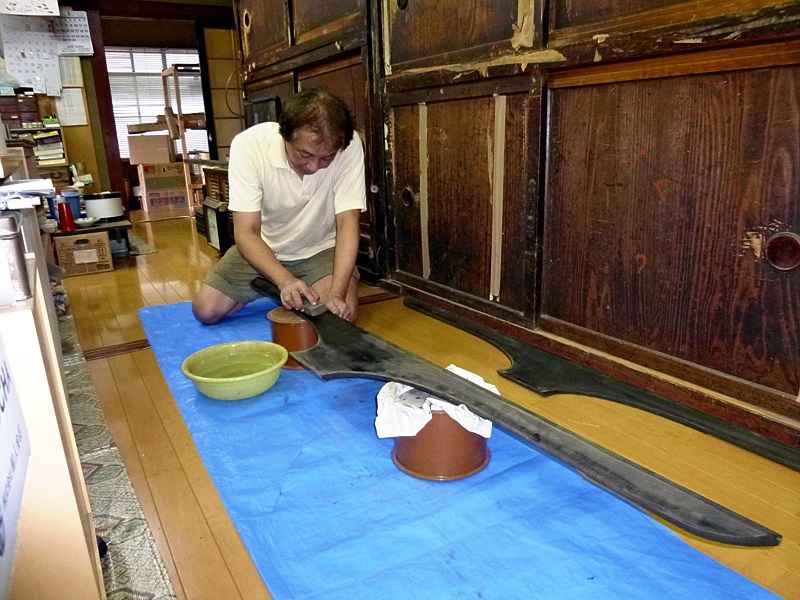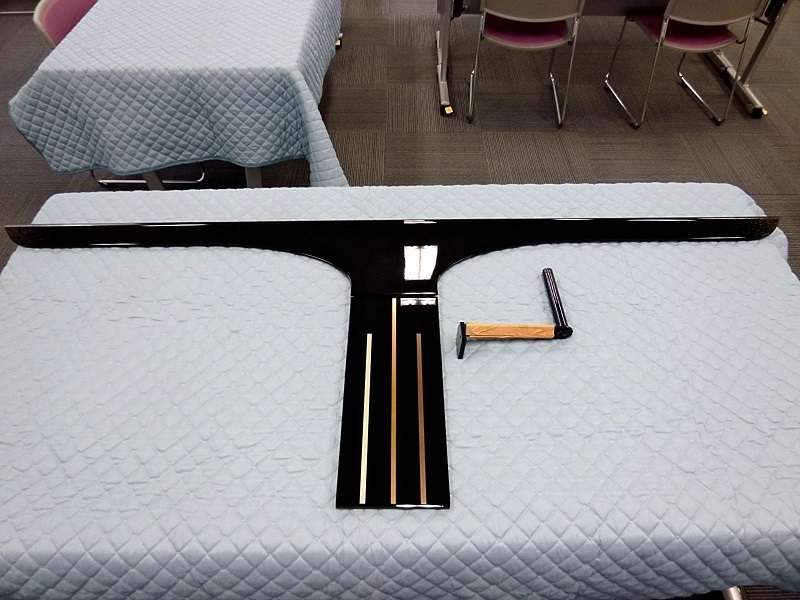
An artisan works on part of a table tennis table using Wajima lacquerware techniques.
7:00 JST, August 5, 2021
Some of the table tennis tables at the Tokyo Games were made with Wajima lacquerware from Ishikawa Prefecture.
The tables were created at the request of a manufacturer who wanted to incorporate lacquer art, one of the greatest achievements of Japanese artisans. Those involved in the tables’ production in Ishikawa Prefecture said they hoped Wajima lacquerware would become known and appreciated overseas as a result of the Games.
In June 2019, San-Ei Corp., a major manufacturer of table tennis tables in Nagareyama, Chiba Prefecture, asked the Wajima Lacquerware Commerce and Industry Cooperative Association to manufacture Wajima-lacquered tables for the Tokyo Games. The association is comprised of lacquerware stores in Wajima, Ishikawa Prefecture.
San-Ei’s table tennis tables were selected as official sporting equipment for the Barcelona and Rio de Janeiro Olympics and Paralympics. The company asked the association to join in its production of tables for the Tokyo Games, to promote Japanese culture overseas through this sporting event being held in their own country.
The Wajima association formed a team of nine artisans, including five young members, to bolster the brand value of Wajima lacquerware and train young artisans through the project. The team started production of the special table tennis tables in autumn 2019.
Usually, lacquerware is made through a division of labor at different workshops, but this time the artisans gathered at the association’s offices. The association oversaw the production process and handled design discussions with San-Ei.
Association director Kensei Sumi, 63, said, “We had a hard time creating a table design typical of Wajima, as we weren’t allowed to use kinpaku gold leaf, which is a distinctive feature of our lacquerware.”
Production of the tables was temporarily suspended due to the postponement of the Games last year, but the tables were completed in April this year. The sides of the tables’ legs were coated with black lacquer and decorated by young artisans with the subori technique — carving the wooden base but not applying any inlay.
Two of the special tables were each sent to the Olympic and Paralympic Games.
Sumi said, “We’re proud to have them used on the main stage of the world’s top sports competition.”

Sections of a table tennis table made with Wajima lacquerware
"Society" POPULAR ARTICLE
-

M4.9 Earthquake Hits Tokyo, Neighboring Prefectures
-

Israeli Tourists Refused Accommodation at Hotel in Japan’s Nagano Pref., Prompting Protest by Israeli Embassy and Probe by Prefecture
-

M7.5 Earthquake Hits Northern Japan; Tsunami Waves Observed in Hokkaido, Aomori and Iwate Prefectures
-

Tsukiji Market Urges Tourists to Avoid Visiting in Year-End
-

High School in Kyoto Says Students Shoplifted during Recent School Trip to Bali, Indonesia
JN ACCESS RANKING
-

Tokyo Economic Security Forum to Hold Inaugural Meeting Amid Tense Global Environment
-

Keidanren Chairman Yoshinobu Tsutsui Visits Kashiwazaki-Kariwa Nuclear Power Plant; Inspects New Emergency Safety System
-

Imports of Rare Earths from China Facing Delays, May Be Caused by Deterioration of Japan-China Relations
-

University of Tokyo Professor Discusses Japanese Economic Security in Interview Ahead of Forum
-

Japan Pulls out of Vietnam Nuclear Project, Complicating Hanoi’s Power Plans
























